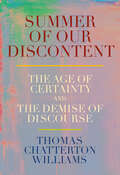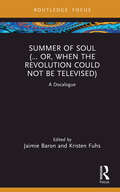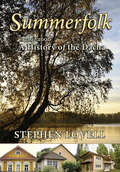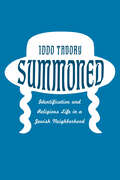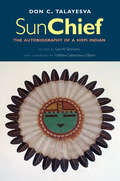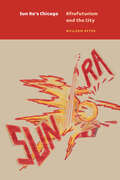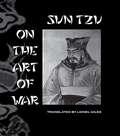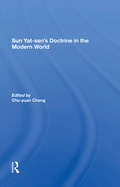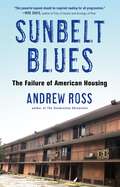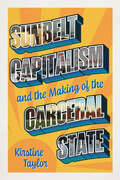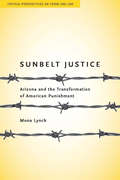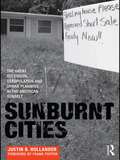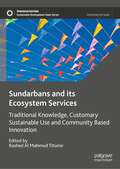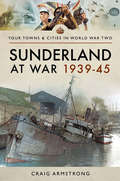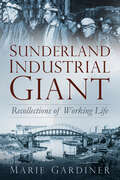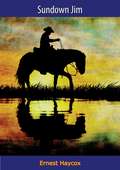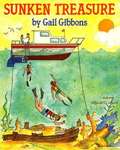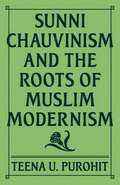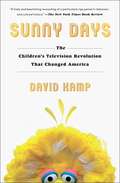- Table View
- List View
Summer of Our Discontent: The Age of Certainty and the Demise of Discourse
by Thomas Chatterton WilliamsAn incisive, culturally observant analysis of the evolving mores, manners and taboos of social justice (&“anti-racist&”) orthodoxy, which has profoundly influenced how we think about diversity and freedom of expression, often with complex or paradoxical consequences.In this provocative book, Thomas Chatterton Williams, one of the most revered and reviled social commentators of our time, paints a clear and detailed picture of the ideas and events that have paved the way for the dramatic paradigm shift in social justice that has taken place over the past few years. Taking aim at the ideology of critical race theory, the rise of an oppressive social media, the fall from Obama to Trump, and the twinned crises of COVID-19 and the murder of George Floyd, Williams documents the extent to which this transition has altered media, artistic creativity, education, employment, policing, and, most profoundly, the ambient language and culture we use to make sense of our lives.Williams also decries how liberalism—the very foundation of an open and vibrant society—is in existential crisis, under assault from both the right and the left, especially in our predominantly networked, Internet-driven monoculture.Sure to be highly controversial, Summer of Our Discontent is a compelling look at our place in a radically changing world.
Summer of Soul: A Docalogue (Docalogue)
by Jaimie Baron Kristen FuhsThe fifth title in the Docalogue series, this book examines Ahmir “Questlove” Thompson’s 2021 documentary, Summer of Soul (…Or, When the Revolution Could Not Be Televised). The award-winning film draws on archival footage and interviews to examine the legacy of the Harlem Cultural Festival, a showcase of Black music staged weekly throughout the summer of 1969. The film interrogates this event as a piece of “forgotten” history and prompts critical reflection on why this history was lost while also raising important questions related to archival preservation and cultural memory. Combining five different perspectives, this book acts both as an intensive scholarly treatment and as a pedagogical guide for how to analyze, theorize, and contextualize a documentary. Together, the essays in this book touch upon key topics related to the study of popular music, musical performance, and audiences; the discovery and reuse of archives and archival documents; and Black studies and American cultural history more broadly. This book will be of interest to students and scholars in multiple areas including but not limited to archival studies, Black studies, cultural studies, documentary studies, historiography, and music studies.
Summer of Soul: A Docalogue (Docalogue)
by Jaimie Baron Kristen FuhsThe fifth title in the Docalogue series, this book examines Ahmir “Questlove” Thompson’s 2021 documentary, Summer of Soul (…Or, When the Revolution Could Not Be Televised).The award-winning film draws on archival footage and interviews to examine the legacy of the Harlem Cultural Festival, a showcase of Black music staged weekly throughout the summer of 1969. The film interrogates this event as a piece of “forgotten” history and prompts critical reflection on why this history was lost while also raising important questions related to archival preservation and cultural memory. Combining five different perspectives, this book acts both as an intensive scholarly treatment and as a pedagogical guide for how to analyze, theorize, and contextualize a documentary. Together, the essays in this book touch upon key topics related to the study of popular music, musical performance, and audiences; the discovery and reuse of archives and archival documents; and Black studies and American cultural history more broadly.This book will be of interest to students and scholars in multiple areas including but not limited to archival studies, Black studies, cultural studies, documentary studies, historiography, and music studies.
Summer of Unrest: Generation Vexed: What the English Riots Don't Tell Us About Our Nation's Youth
by Nikesh Shukla Kieran YatesSummer of Unrest (Slight Return). For a few days at the start of August, England was gripped by the riots that erupted in its city centres. Although there were various motivations behind the trouble and a broad spectrum of ages and backgrounds involved, the front pages were emblazoned with images of hooded youths running amok and stories of the revenge of the feral underclass.In this final part of the Brain Shots: Summer of Unrest series, Nikesh Shukla and Kieran Yates interrogate whether young people are deliberately conforming to a stereotype foisted upon them, and point instead to the creativity and entrepreneurialism that are defining a supposedly 'lost' generation. An antidote to the broadsheet commentariat, this street-level view of the defining moment of the Summer of Unrest finds much to inspire hope and confidence for our future.
Summerfolk: A History of the Dacha, 1710–2000
by Stephen LovellThe dacha is a sometimes beloved, sometimes scorned Russian dwelling. Alexander Pushkin summered in one; Joseph Stalin lived in one for the last twenty years of his life; and contemporary Russian families still escape the city to spend time in them. Stephen Lovell's generously illustrated book is the first social and cultural history of the dacha. Lovell traces the dwelling's origins as a villa for the court elite in the early eighteenth century through its nineteenth-century role as the emblem of a middle-class lifestyle, its place under communist rule, and its post-Soviet incarnation. A fascinating work rich in detail, Summerfolk explores the ways in which Russia's turbulent past has shaped the function of the dacha and attitudes toward it. The book also demonstrates the crucial role that the dacha has played in the development of Russia's two most important cities, Moscow and St. Petersburg, by providing residents with a refuge from the squalid and crowded metropolis. Like the suburbs in other nations, the dacha form of settlement served to alleviate social anxieties about urban growth. Lovell shows that the dacha is defined less by its physical location"usually one or two hours" distance from a large city yet apart from the rural hinterland—than by the routines, values, and ideologies of its inhabitants. Drawing on sources as diverse as architectural pattern books, memoirs, paintings, fiction, and newspapers, he examines how dachniki ("summerfolk") have freed themselves from the workplace, cultivated domestic space, and created informal yet intense intellectual communities. He also reflects on the disdain that many Russians have felt toward the dacha, and their association of its lifestyle with physical idleness, private property, and unproductive use of the land. Russian attitudes toward the dacha are, Lovell asserts, constantly evolving. The word "dacha" has evoked both delight in and hostility to leisure. It has implied both the rejection of agricultural labor and, more recently, a return to the soil. In Summerfolk, the dacha is a unique vantage point from which to observe the Russian social landscape and Russian life in the private sphere.
Summers of Fire: A Memoir of Adventure, Love and Courage
by Linda StraderLinda Strader is one of the first women hired on a fire crew with the U.S. Forest Service. A naïve twenty-year-old in the mid-1970s, she discovers fighting wildfires is challenging—but in a man's world, they became only one of the challenges she would face. Battling fire is exhilarating, yet exhausting; the discrimination real and sometimes in her face. Summers of Fire is an Arizona to Alaska adventure story that honestly recounts the seven years Strader ventures into the heart of fires that scorch the land, vibrant friendships that fire the soul, and deep love that ends in devastating heartbreak.
Summoned: Identification and Religious Life in a Jewish Neighborhood
by Iddo TavoryOn a typical weekday, men of the Beverly-La Brea Orthodox community wake up early, beginning their day with Talmud reading and prayer at 5:45am, before joining Los Angeles' traffic. Those who work "Jewish jobs"--teachers, kosher supervisors, or rabbis--will stay enmeshed in the Orthodox world throughout the workday. But even for the majority of men who spend their days in the world of gentiles, religious life constantly reasserts itself. Neighborhood fixtures like Jewish schools and synagogues are always after more involvement; evening classes and prayers pull them in; the streets themselves seem to remind them of who they are. And so the week goes, culminating as the sabbatical observances on Friday afternoon stretch into Saturday evening. Life in this community, as Iddo Tavory describes it, is palpably thick with the twin pulls of observance and sociality. In Summoned, Tavory takes readers to the heart of the exhilarating--at times exhausting--life of the Beverly-La Brea Orthodox community. Just blocks from West Hollywood's nightlife, the Orthodox community thrives next to the impure sights, sounds, and smells they encounter every day. But to sustain this life, as Tavory shows, is not simply a moral decision they make. Being Orthodox is to be constantly called into being. People are reminded of who they are as they are called upon by organizations, prayers quorums, the nods of strangers, whiffs of unkosher food floating through the street, or the rarer Anti-Semitic remarks. Again and again, they find themselves summoned both into social life and into their identity as Orthodox Jews. At the close of Tavory's fascinating ethnography, we come away with a better understanding of the dynamics of social worlds, identity, interaction and self--not only in Beverly-La Brea, but in society at large.
Summoning the Fates: A Woman's Guide to Destiny
by Zsuzsanna E. BudapestBudapest, a strong voice in feminine spirituality, explores the growth cycles of women and the role of fate/destiny, with the theme of taking control and getting the most out of each cycle. It is an excellent guide for women young and old.
Sun Chief
by Robert V. Hine Don C. Talayesva Leo W. Simmons Prof. Matthew Sakiestewa GilbertFirst published in 1942, Sun Chief is the autobiography of Hopi Chief Don C. Talayesva and offers a unique insider view on Hopi society. In a new Foreword, Matthew Sakiestewa Gilbert situates the book within contemporary Hopi studies, exploring how scholars have used the book since its publication more than seventy years ago.
Sun Ra's Chicago: Afrofuturism and the City (Historical Studies of Urban America)
by William SitesSun Ra (1914–93) was one of the most wildly prolific and unfailingly eccentric figures in the history of music. Renowned for extravagant performances in which his Arkestra appeared in neo-Egyptian garb, the keyboardist and bandleader also espoused an interstellar cosmology that claimed the planet Saturn as his true home. In Sun Ra’s Chicago, William Sites brings this visionary musician back to earth—specifically to the city’s South Side, where from 1946 to 1961 he lived and relaunched his career. The postwar South Side was a hotbed of unorthodox religious and cultural activism: Afrocentric philosophies flourished, storefront prophets sold “dream-book bibles,” and Elijah Muhammad was building the Nation of Islam. It was also an unruly musical crossroads where the man then known as Sonny Blount drew from an array of intellectual and musical sources—from radical nationalism, revisionist Christianity, and science fiction to jazz, blues, Latin dance music, and pop exotica—to construct a philosophy and performance style that imagined a new identity and future for African Americans. Sun Ra’s Chicago shows that late twentieth-century Afrofuturism emerged from a deep, utopian engagement with the city—and that by excavating the postwar black experience of Sun Ra’s South Side milieu, we can come to see the possibilities of urban life in new ways.
Sun Tzu On The Art Of War: Sun Tzu's Ultimate Treatise On Strategy For War, Leadership, And Life (Classics On War And Politics Ser. #Vol. 1)
by Lionel GilesFirst Published in 2005. This is the classic translation of the Chinese military masterpiece; it preserves the character and nuances of the Chinese original. The inspiration of Mao Tse Tung and countless generations of military leaders, it was written in antiquity and consists of thirteen chapters that reflect the mind of a born strategist and practical soldier whose maxims, full of acuteness and common sense, relate as much to the present day as they do to the military conditions of the time when they were written. As useful in the pursuit of success in modem business as it was in ancient warfare, this volume also relates to all aspects of personal and everyday life in which you must either be a winner or a loser.
Sun Yat-sen's Doctrine In The Modern World
by Chu-yuan Cheng Hung-Chao Tai Harold Z Schiffrin Yu-Long LingThis volume focuses on Sun Yat-sen's social, political, and economic ideas as seen in his major work, The Three Principles of the People, which discusses nationalism, democracy, and people's welfare, examining his doctrines as well as a his ideas with other contemporary ideologies.
Sunbelt Blues: The Failure of American Housing
by Andrew RossAn eye-opening investigation of America’s rural and suburban housing crisis, told through a searing portrait of precarious living in Disney World's backyard.Today, a minimum-wage earner can afford a one-bedroom apartment in only 145 out of 3,143 counties in America. One of the very worst places in the United States to look for affordable housing is Osceola County, Florida.Once the main approach to Disney World, where vacationers found lodging on their way to the Magic Kingdom, the fifteen-mile Route 192 corridor in Osceola has become a site of shocking contrasts. At one end, global investors snatch up foreclosed properties and park their capital in extravagant vacation homes for affluent visitors, eliminating the county’s affordable housing in the process. At the other, underpaid tourist industry workers, displaced families, and disabled and elderly people subsisting on government checks cram themselves into dilapidated, roach-infested motels, or move into tent camps in the woods.Through visceral, frontline reporting from the motels and encampments dotting central Florida, renowned social analyst Andrew Ross exposes the overlooked housing crisis sweeping America’s suburbs and rural areas, where residents suffer ongoing trauma, poverty, and nihilism. As millions of renters face down evictions and foreclosures in the midst of the COVID-19 recession, Andrew Ross reveals how ineffective government planning, property market speculation, and poverty wages have combined to create this catastrophe. Urgent and incisive, Sunbelt Blues offers original insight into what is quickly becoming a full-blown national emergency.
Sunbelt Capitalism and the Making of the Carceral State (Chicago Series in Law and Society)
by Kirstine TaylorThe story of how the American South became the most incarcerated region in the world’s most incarcerated nation. Sunbelt Capitalism and the Making of the Carceral State examines the evolution of southern criminal punishment from Jim Crow to the dawn of mass incarceration, charting this definitive era of carceral transformation and expansion in the southern United States. The demise of the county chain gang, the professionalization of police, and the construction of large-scale prisons were among the sweeping changes that forever altered the southern landscape and bolstered the region’s capacity to punish. What prompted this southern revolution in criminal punishment? Kirstine Taylor argues that the crisis in the cotton fields and the arrival of Sunbelt capitalism in the south’s rising metropolises prompted lawmakers to build expansive, modern criminal punishment systems in response to Brown v. Board of Education and the Black freedom movements of the 1960s and ‘70s. Taking us inside industry-hunting expeditions, school desegregation battles, the sit-in movement, prisoners’ labor unions, and policy commissions, Taylor tells the story of how a modernizing south became the most incarcerated region in the globe’s most incarcerated nation.
Sunbelt Justice
by Mona LynchIn the early 1970s there were fewer than 500,000 prisoners incarcerated in Federal and state prisons in the US: a rate of approximately 100 imprisoned persons per 100,000 of population. Today more than 1. 5 million people are imprisoned in the US at a rate of more than 400 per 100,000 people in the general population. Where the penal system thirty years ago was focused on rehabilitation, the emphasis now is on punishment of criminals and keeping society safe. This book looks at Arizona as a microcosm of the US as a whole in tracking trends and changes that have taken place in criminal justice over time. Annotation c2010 Book News, Inc. , Portland, OR (booknews. com)
Sunburnt Cities: The Great Recession, Depopulation and Urban Planning in the American Sunbelt
by Justin B. HollanderIn recent years there has been a growing focus on urban and environmental studies, and the skills and techniques needed to address the wider challenges of how to create sustainable communities. Central to that demand is the increasing urgency of addressing the issue of urban decline, and the response has almost always been to pursue growth policies to attempt to reverse that decline. The track record of growth policies has been mixed at best. Until the first decade of the twenty-first century decline was assumed to be an issue only for former industrial cities – the so-called Rust Belt. But the sudden reversal in growth in the major cities of the American Sunbelt has shown that urban decline can be a much wider issue. Justin Hollander’s research into urban decline in both the Sun and Rust Belts draws lessons planners and policy makers that can be applied universally. Hollander addresses the reasons and statistics behind these "shrinking cities" with a positive outlook, arguing that growth for growth’s sake is not beneficial for communities, suggesting instead that urban development could be achieved through shrinkage. Case studies on Phoenix, Flint, Orlando and Fresno support the argument, and Hollander delves into the numbers, literature and individual lives affected and how they have changed in response to the declining regions. Written for urban scholars and to suit a wide range of courses focused on contemporary urban studies, this text forms a base for all study on shrinking cities for professionals, academics and students in urban design, planning, public administration and sociology.
Sundarbans and its Ecosystem Services: Traditional Knowledge, Customary Sustainable Use and Community Based Innovation (Sustainable Development Goals Series)
by Rashed Al Mahmud TitumirThis edited volume focuses on the largest single tract contiguous mangrove forest in the world— the Sundarbans— exploring traditional knowledge, customary sustainable use and community-based innovation. The book analyses the current state of the Sundarbans, its multiple values and ecosystem services, to demonstrate that Indigenous and local knowledge (ILK) is essential for the conservation and sustainable use of natural resources. Not only does this play an integral role in realising SDG 14 (life below water) and SDG 15 (life on land), it also actively contributes towards achieving many other goals and targets. It contributes a new understanding of sustainability by bringing human-nature relationships in view of the renewed interest in biodiversity and climate change— heightened by the COVID-19 pandemic. The book links scientific knowledge with multi, inter, trans- disciplinary nature of ILK for sustainable development collected from the ground. It challenges the market-based approach in valuing the natural resources, and demonstrates that the valuation of environmental resources through market penetration pricing does not reckon the social benefits and values coproduced through complementarity between humans and nature.
Sundays with Vlad: From Pennsylvania to Transylvania, One Man's Quest to Live in the World of the Undead
by Paul BibeauFrom the moment his bully of an older sister jumped out of a dresser drawer, baring her convincing glow-in-the-dark vampire fangs, Paul Bibeau was sold on monsters. Though he claims to have been scarred for life by this traumatic childhood experience, he developed an uncanny obsession with the undead. Years later, his fixation led him to revise his honeymoon plans with his unsuspecting wife to include a side-trip to Wallachia, Romania to visit the historical Castle Dracula -- the castle of Vlad the Impaler. Clutching his guidebook like a Bible, Bibeau set off on a sometimes disturbing, often hilarious journey through the legend of Dracula and the country from whence he came. From movies to novels to the cereal box, Dracula has become quite the cult figure over the centuries, though locals barely bat an eyelid at the surprising breadth of the subculture devoted to him. As if visiting the home of the legendary Dracula weren't enough, Bibeau digs through Bram Stoker's original manuscript, meets with the president of the Dracula Fan Club, and even marches in the Transylvania Day Parade as a giant garlic bulb, all in the hopes of getting at the stone cold heart of vampire mania. Filled with equal parts humor, irony, and reverence, Sundays with Vlad is an alternative travelogue that will appeal both to vampire fans as well as those fascinated by a segment of society they never see during the light of day.
Sunderland at War 1939–45 (Your Towns & Cities in World War Two)
by Craig ArmstrongThis local history explores the wartime contributions and sacrifices of a strategically significant English port town during WWII.Located on the River Wear, Sunderland was a vital hub for shipbuilding and coal exportation. During the Second World War, these important attributes marked it as a prime target for the Luftwaffe. The town experienced numerous air raids, including one which caused devastating casualties and structural damage. The authorities struggled to provide adequate shelters and Air Raid Precautions services.Sunderland also had a proud tradition of military service. Many joined the local Army regiment, the famed Durham Light Infantry, which saw action in almost every theater of the war. Other brave Wearsiders joined the Merchant Navy, the Royal Navy, and the Royal Air Force. Some served in Bomber Command, seeking vengeance for the brutal bombing of their home town.
Sunderland, Industrial Giant: Recollections of Working Life
by Marie GardinerSunderland was once one of Britain’s industrial giants. Famous for its shipyards, mines and glass-making, it thrived at a time when its country needed it most. After the Second World War the town saw incredible change, as the heavy industry that seemed so permanent, faded and died. How do you cope with the loss of centuries of working tradition? These are the stories of the people who worked through this evolution, watched their town change around them and become a city – the people who saw the end of one era and the beginning of a challenging new one.
Sundown Jim
by Ernest HaycoxTHE ONLY WAY DEPUTY JIM MAJORS COULD CLEAN UP RESERVATION WAS TO DRAW FIRST—AND KEEP SHOOTING.The angular man in the middle of the square stirred in his tracks and began to talk. “Listen. You’re lookin’ for Ed Dale. I’m Dale.”Majors said, “All right. You’re the man I want.”“You can come and get me. I’ll be right here.”“No,” said Majors. “Drop your belt and walk this way.”“No chance, mister. No chance.”Time narrowed down and the moments were like pulsebeats. Ben Maffitt called in a loud voice, “Look, Majors!”—trying to draw his attention from Dale, whose elbow faded backward as he went for his gun.There are sights that cut an unforgettable pattern in a man’s mind and this was one of them—Ed Dale’s body bending over from the effort of his draw, his feet planted wide apart in the dust. That was how he was when Majors’ bullet struck him. He was dead before he hit the ground.Majors turned slowly. “What was it you wanted me to look at, Maffitt?”
Sundown Towns
by James W. Loewen"Don't let the sun go down on you in this town." We equate these words with the Jim Crow South but, in a sweeping analysis of American residential patterns, award-winning and bestselling author James W. Loewen demonstrates that strict racial exclusion was the norm in American towns and villages from sea to shining sea for much of the twentieth century.Weaving history, personal narrative, and hard-nosed analysis, Loewen shows that the sundown town was-and is-an American institution with a powerful and disturbing history of its own, told here for the first time. In Michigan, Indiana, Ohio, Illinois, Missouri, Pennsylvania, and elsewhere, sundown towns were created in waves of violence in the early decades of the twentieth century, and then maintained well into the contemporary era.Sundown Towns redraws the map of race relations, extending the lines of racial oppression through the backyard of millions of Americans-and lobbing an intellectual hand grenade into the debates over race and racism today.
Sunken Treasure
by Gail GibbonsGail Gibbons writes about an ancient Spanish galleon, the Atocha, describing the sinking; the search; the find; and the preservation, cataloging and eventual distribution of the treasure. She also devotes a page each to other famous treasure hunts. Handsomely designed and easily accessible. A Reading Rainbow Featured Selection Children's Choices for 1989
Sunni Chauvinism and the Roots of Muslim Modernism
by Teena U. PurohitMuslim intellectuals who sought to establish the boundaries of modern Muslim identityMuslim modernism was a political and intellectual movement that sought to redefine the relationship between Islam and the colonial West in the late nineteenth and early twentieth centuries. Spearheaded by Muslim leaders in Asia and the Middle East, the modernist project arose from a desire to reconcile Islamic beliefs and practices with European ideas of secularism, scientific progress, women&’s rights, and democratic representation. Teena Purohit provides innovative readings of the foundational thinkers of Muslim modernism, showing how their calls for unity and reform led to the marginalization of Muslim minority communities that is still with us today.Sunni Chauvinism and the Roots of Muslim Modernism offers fresh perspectives on figures such as Jamal al-Din al-Afghani, Muhammad Abduh, Muhammad Iqbal, and Abul A&’la Mawdudi. It sheds light on the exclusionary impulses and Sunni normative biases of modernist Muslim writers and explores how their aim to unite the global Muslim community—which was stagnant and fragmented in their eyes—also created lasting divisions. While modernists claimed to represent all Muslims when they asserted the centrality and significance of unity, they questioned the status of groups such as Ahmadis, Bahais, and the Shia more broadly.Addressing timely questions about religious authority and reform in modern Islam, this incisive book reveals how modernist notions of Islam as a single homogeneous tradition gave rise to enduring debates about who belongs to the Muslim community and who should be excluded.
Sunny Days: The Children's Television Revolution That Changed America
by David KampOne of the &“Best Books&” of the year from The Smithsonian, The Washington Independent Review, and more! From bestselling writer David Kamp, the &“fun, fascinating, and surprisingly touching,&” (People) behind-the-scenes story of the cultural heroes who created the beloved children&’s TV programs Sesame Street, The Electric Company, Mister Rogers&’ Neighborhood, Free to Be…You and Me, and Schoolhouse Rock!—which transformed American childhood for the better, teaching kids about diversity, the ABCs, and feminism through a fun, funky 1970s lens. With a foreword by Questlove.In 1970, on a soundstage on Manhattan&’s Upper West Side, a group of men, women, and Muppets of various ages and colors worked doggedly to finish the first season of a children&’s TV program that was not yet assured a second season: Sesame Street. They were conducting an experiment to see if television could be used to better prepare disadvantaged preschoolers for kindergarten. What they didn&’t know then was that they were starting a cultural revolution that would affect all American kids. In Sunny Days, bestselling author David Kamp captures the unique political and social moment that gave us not only Sesame Street, but also Fred Rogers&’s gentle yet brave Mister Rogers&’ Neighborhood; Marlo Thomas&’s unabashed gender politics primer Free to Be…You and Me; Schoolhouse Rock!, an infectious series of educational shorts dreamed up by Madison Ave admen; and more, including The Electric Company and ZOOM. It was a unique time when an uncommon number of media professionals and thought leaders leveraged their influence to help children learn—and, just as notably, a time of unprecedented buy-in from American parents. &“Sunny Days is full of such nostalgic jolts…it makes the era a pleasure to revisit&” (The Wall Street Journal) and captures a wondrous period in the US when a determined few proved that, with persistence and effort, they could change the lives of millions. It is &“a lively and bewitching recounting of a particularly ripe period in television and cultural history&” (The New York Times Book Review) and, as the Los Angeles Times notes, &“a sublime book about a variety of creative people coming together not in the pursuit of fame or money, but to enrich the lives of children.&”
